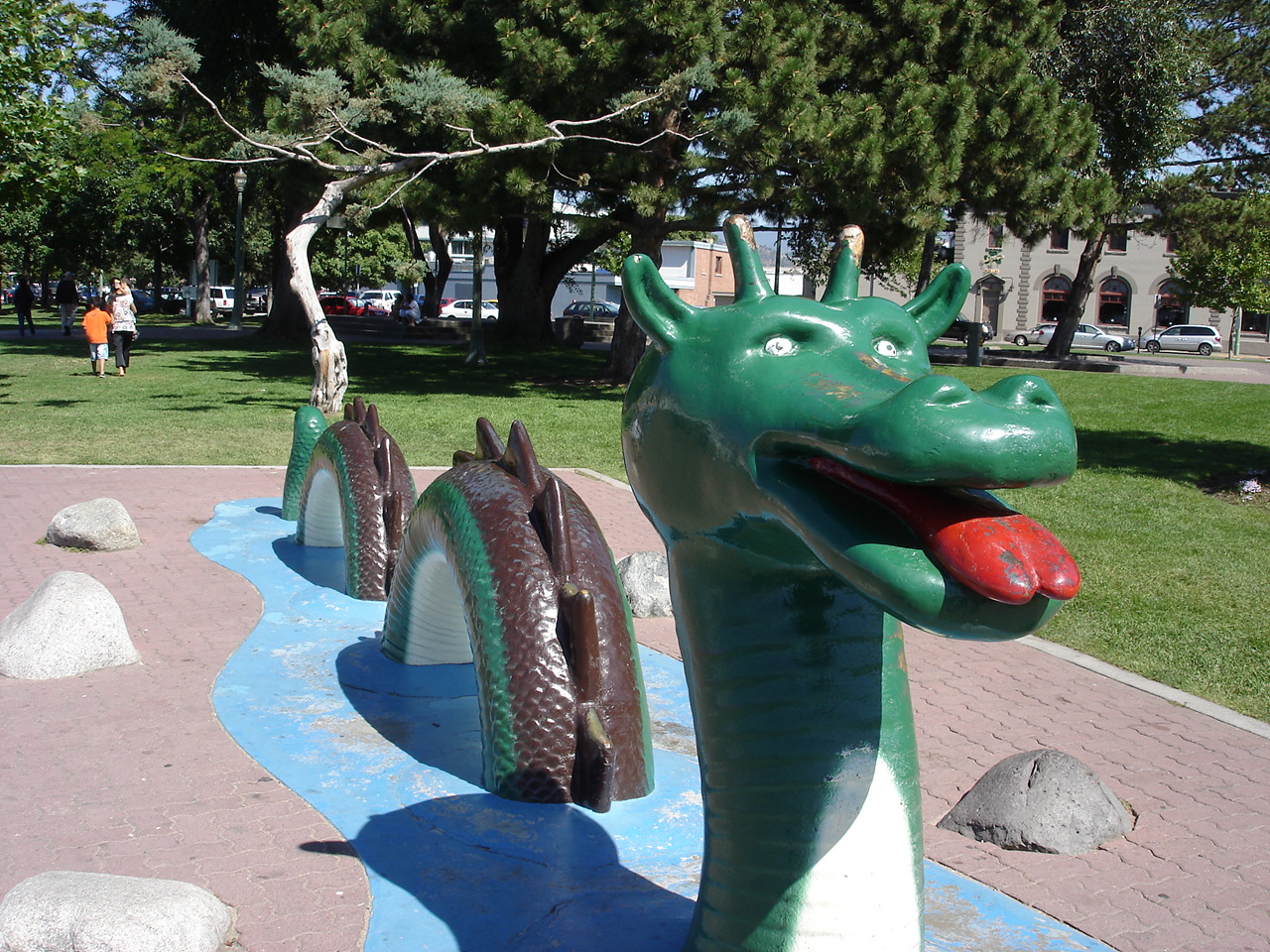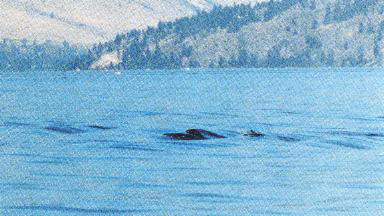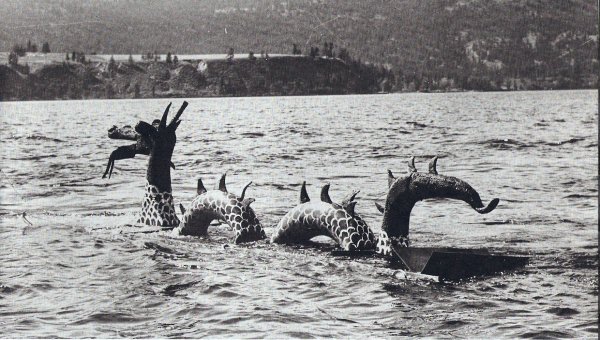Post by MoMo on Mar 10, 2012 23:19:40 GMT -6
Ogopogo

Grouping: Cryptid
Sub grouping: Lake Monster
First Reported: 1860 + prior local legend
Country: Canada
Region: Lake Okanagan, British Columbia
Habitat: Water
Ogopogo or Naitaka (Salish: n'ha-a-itk, "lake demon") is the name given to a cryptid lake monster reported to live in Okanagan Lake, in British Columbia, Canada. Ogopogo has been allegedly seen by Native Americans since the 19th century. The most common description of Ogopogo is a forty- to fifty-foot-long (12 to 15 m) sea serpent. It has supposedly been photographed and even been caught on tape.
Description


Descriptions vary, but certain characteristics have been repeated through the decades is that Ogopogo is green with a snake like body about 25 metres long.
Sightings
Proponents of the Ogopogo's existence claim that the first documented sightings of the monster date back to around 1872, and occurred as the area was being colonized by European settlers. Perhaps the earliest mention of the Ogopogo was the story of a man in 1860 leading horses that were swimming across the lake near Rattlesnake Island. They were pulled under by some unseen and unknown force later attributed to the then common native myth of the Ogopogo.
In 1926 a sighting is claimed to have occurred at an Okanagan Mission beach. This event was supposedly witnessed by about thirty cars of people who all claimed to have seen the same thing. It was also in this year that the editor of the Vancouver Sun, Bobby Carter, wrote, "Too many reputable people have seen to ignore the seriousness of actual facts."
The first alleged film of the creature was made in 1968 by Art Holding. The film which is often incorrectly referred to as the 'Folden' Film shows a dark object propelling itself through shallow water near the shore. The film was shot from on a hill above the shore.
Ogopogo was allegedly filmed again in 1989 by a used car salesman, Ken Chaplin, who with his father, Clem Chaplin, claimed to have seen a snake-like animal swimming in the lake, which flicked its tail to create a splash. Some believe that the animal the Chaplins saw was simply a beaver, because the tail splashing is a well-known characteristic of beavers. However, Chaplin alleges the animal he saw was 15 feet (4.6 m) long, far larger than a beaver (beavers are approximately 4 feet (1.2 m) long). A few weeks later, Chaplin came back with his father and his daughter and filmed it again.
British cryptozoologist Karl Shuker has categorized the Ogopogo as a 'many hump' variety of lake monster, and suggested it may be a kind of primitive serpentine whale such as Basilosaurus. However, because the physical evidence for the beast is limited to unclear photographs and film, it has also been suggested that the sightings are misidentifications of common animals, such as otters, and inanimate objects, such as floating logs. Another suggestion is that the Ogopogo is a lake sturgeon. It is also possible in some cases that Ogopogo could be the misidentification of a seiche, a standing wave in a lake that travels below the surface in a long serpentine motion.




Grouping: Cryptid
Sub grouping: Lake Monster
First Reported: 1860 + prior local legend
Country: Canada
Region: Lake Okanagan, British Columbia
Habitat: Water
Ogopogo or Naitaka (Salish: n'ha-a-itk, "lake demon") is the name given to a cryptid lake monster reported to live in Okanagan Lake, in British Columbia, Canada. Ogopogo has been allegedly seen by Native Americans since the 19th century. The most common description of Ogopogo is a forty- to fifty-foot-long (12 to 15 m) sea serpent. It has supposedly been photographed and even been caught on tape.
Description


Descriptions vary, but certain characteristics have been repeated through the decades is that Ogopogo is green with a snake like body about 25 metres long.
Sightings
Proponents of the Ogopogo's existence claim that the first documented sightings of the monster date back to around 1872, and occurred as the area was being colonized by European settlers. Perhaps the earliest mention of the Ogopogo was the story of a man in 1860 leading horses that were swimming across the lake near Rattlesnake Island. They were pulled under by some unseen and unknown force later attributed to the then common native myth of the Ogopogo.
In 1926 a sighting is claimed to have occurred at an Okanagan Mission beach. This event was supposedly witnessed by about thirty cars of people who all claimed to have seen the same thing. It was also in this year that the editor of the Vancouver Sun, Bobby Carter, wrote, "Too many reputable people have seen to ignore the seriousness of actual facts."
The first alleged film of the creature was made in 1968 by Art Holding. The film which is often incorrectly referred to as the 'Folden' Film shows a dark object propelling itself through shallow water near the shore. The film was shot from on a hill above the shore.
Ogopogo was allegedly filmed again in 1989 by a used car salesman, Ken Chaplin, who with his father, Clem Chaplin, claimed to have seen a snake-like animal swimming in the lake, which flicked its tail to create a splash. Some believe that the animal the Chaplins saw was simply a beaver, because the tail splashing is a well-known characteristic of beavers. However, Chaplin alleges the animal he saw was 15 feet (4.6 m) long, far larger than a beaver (beavers are approximately 4 feet (1.2 m) long). A few weeks later, Chaplin came back with his father and his daughter and filmed it again.
British cryptozoologist Karl Shuker has categorized the Ogopogo as a 'many hump' variety of lake monster, and suggested it may be a kind of primitive serpentine whale such as Basilosaurus. However, because the physical evidence for the beast is limited to unclear photographs and film, it has also been suggested that the sightings are misidentifications of common animals, such as otters, and inanimate objects, such as floating logs. Another suggestion is that the Ogopogo is a lake sturgeon. It is also possible in some cases that Ogopogo could be the misidentification of a seiche, a standing wave in a lake that travels below the surface in a long serpentine motion.









